#positive health
Explore tagged Tumblr posts
Text
Book of the Day - Positive Health
Today’s Book of the Day is Positive Health, written by Jolanta Burke, Pádraic J. Dunne, Trudy Meehan, Ciaran A. O’Boyle, and Christian van Nieuwerburgh in 2022 and published by Routledge. The authors are all experts in Positive Psychology, renowned authors, researchers, consultants, and coaches. Positive Health, by Jolanta Burke, Pádraic J. Dunne, Trudy Meehan, Ciaran A. O’Boyle, and Christian…
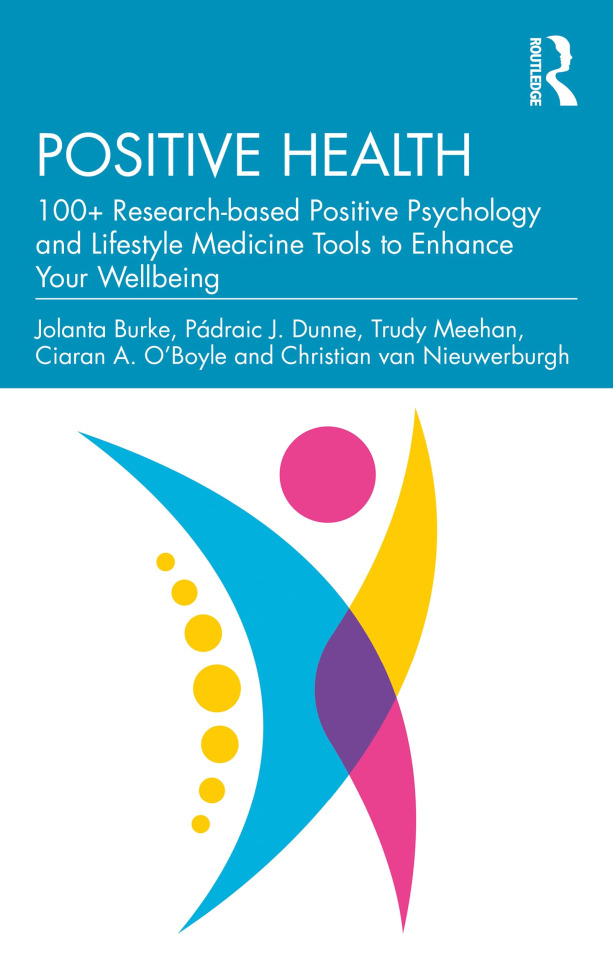
View On WordPress
#Book Of The Day#book recommendation#book review#books#bookstagram#booktok#Christian van Nieuwerburgh#Ciaran A. O’Boyle#health#olanta Burke#Pádraic J. Dunne#Positive Health#Psychology#Raffaello Palandri#Routledge#Trudy Meehan#Well-Being#wellbeing
12 notes
·
View notes
Text
Lekker met Nederland! vol.6
(元Dr.コトーの蘭学手記: Blog about life in the Netherlands by a Japanese doctor)
皆さん、2023年になりましたね!
新年初のブログは昨年の第一弾の続きとなるオランダの「ポジティヴヘルス」第二弾の応用編です。今回は前回のポジティヴヘルスの知識をベースに、具体的にどのようにPositive Healthが使用されているのか、オランダの診療所を例にご紹介したいと思います。
Hello everyone! The year 2023 started and time flies so fast.
Thank you for waiting for my update.
In this blog, the first one of this year, I would like to tell you about application of ‘Positive Health’.
Based on the knowledge from my previous blog, which is about ‘Introduction of Positive Health’, I will elaborate how Positive Health is used in practical situations, through the examples of Dutch clinic.
【診療の場におけるポジティヴヘルス】
Part. 1 クモの巣図を作成しよう Let’s make a spider web diagram!
Positive Healthが最初に使用されるようになったのはクリニックなどで患者と医療者が健康について話し合う場面でした。
ポジティヴヘルスのクモの巣図をもう一度おさらいすると、①「身体的機能」、②「メンタルウェルビーイング」、③「生きがい」、④「生活の質」、⑤「社会参加」、⑥「日常機能」の6領域があります。
それぞれの領域につき、7問の細かい問いがあり(計42問)、それぞれの質問に対して、0から10点の評価をつけてもらいます(0:全く当てはまらない〜10:完全に当てはなる)。
更に最新版のクモの巣図2.0バージョン(図1:オランダ語)では「身体的機能」にセクシュアリティに関する質問、更に「生活の質」に親密性に関する質問を加えた合計全44項目から構成された質問紙を使用します。
また、どの世代にもわかりやすいようにクモの巣図には「成人用」、「思春期(16-25歳)用」、「小児(8-16歳)用」など年齢別に質問も対応しています。
Positive Health (PH) was originally introduced in clinical practice, where patients and health care providers discussed health.
Reviewing the spider web diagram of PH again, there are six domains: (1) "bodily functions", (2) "mental well-being", (3) "meaningfulness", (4) "quality of life", (5) "participation", and (6) "daily functioning".
For each domain, there are 7 detailed questions (42 questions in total), and the participants are asked to rate each question on a scale of 0 to 10 (0: not applicable at all to 10: completely applicable).
In addition, the latest version of the Spider's Web Diagram 2.0 (Figure 1: in Dutch) uses a questionnaire with a total of 44 items, including questions on sexuality in "bodily functions" and questions on intimacy in "quality of life" .
The spider web diagram also differs according to different age groups, such as "adult," "adolescent (16-25 years)," or "child (8-16 years), with different detailed questions in order to make it easier to understand the concept of PH for all generations.
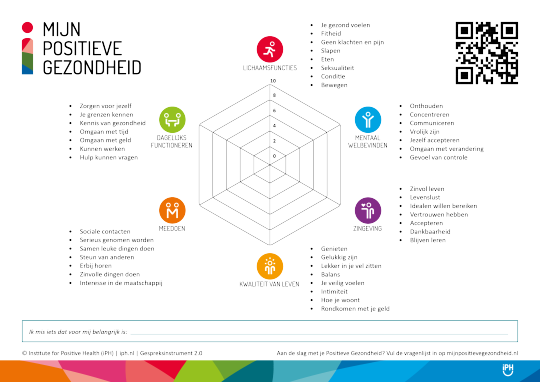
引用(Reference): Institute for Positive Health (iPH) iph.nl Gespreksinstrument2.0
成人用のクモの巣図に関する質問の例をそれぞれ挙げると、
①身体的機能
→「身体・体調について不満や痛みはありますか?」
②メンタルウェルビーイング
→「物事に集中できていますか?」
③生きがい
→「今の生活を受け入れていますか?」
④生活の質
→「幸せと感じていますか?」
⑤社会参加
→「誰か他者からの助けや支援はありますか?」
⑥日常機能
→「日々の生活で時間の管理はできていますか?」
この質問紙を患者に予め���宅もしくはクリニックで記入してもらいます。
クモの巣図にはそれぞれの領域ごとに質問の点数の平均を取って反映されます。
さて、ここからがPHの大事なステップ、クモの巣図の振り返りです。
Examples of detailed questions on the spider web diagram for adults are as follows
1) Bodily functions
→"Do you have any complaints or pain about your body or physical condition?”
(2) Mental well-being
→ "Are you able to concentrate on things?”
3) Meaningfulness
→”Do you accept your life as it is now?”
(4) Quality of life
→”Do you feel happy?”
5) Participation
→”Do you have any help or support from others?”
6) Daily functioning
→”Are you able to manage your time schedule in your daily life?”
Patients are asked to fill out this questionnaire at home or at the clinic.
The spider web diagram will reflect the average of the scores of the questions for each dimention.
Part.2 クモの巣図を振り返ろう Reflection of the spider web diagram
振り返りにあたり、2つの方法を用います。
①問題解決志向型の問いかけ
②アクションウィール法
それぞれについて見ていきましょう。
①問題解決志向型の問いかけ
これは患者自身に変化をもたらすような問いかけの方法です。
具体的には、クモの巣図を作成後、以下のような質問を患者に行います。
あなたが希望している状態はどんなことでしょうか?
それはどんな違いを生みますか?
何が効果的だと思いますか?
次のステップとはどういったものですか?
There are two practical methods for reflection.
(1) Ask solution-oriented questions
(2) Use the Action Wheel
(1) Solution-oriented questions
The aim of the question is to help care providers make patients think differently and to create a context for change. Specifically, after creating a spider web diagram, the following questions are asked to the patient.
- What do you hope for?
- What difference will that make?
- What will be effective?
- What will be the next sign of progress? Or: What will be your next step?
では問題解決志向型の問いかけを用いた具体例を見てみましょう。
Now let's see the example of using solution-oriented questions.
患者は58歳男性、3ヶ月前に心筋梗塞になった方です。
2人の娘と妻と一緒に家庭医を訪問しました。
事前のクモの巣図は全体的に6-7点程度の分布でした。
医師が現在の治療、特にリハビリテーションについて聞かれた際、患者は「リハビリはうんざり、何も改善している気がしない」と答えました。
そこで医師はまず「あなたが希望している状態はどんなことでしょうか?」と質問しました。
すると彼は声を詰まら��ながら、「子供ともっと良い関係を作りたい」と回答しました。
医師は患者の思いを汲み取りながら、「この質問はあなたを感情的にさせますか?」と念押しすると患者はいよいよ泣き出しました。
続けて医師は娘に「父の泣いている姿をよくみますか?」と質問すると、娘たちは「父が泣いているのを見るのはこれが人生で2回目です」と答えました。
医師が一回目はいつかと尋ねたところ、娘は「それは3ヶ月前で、父が心筋梗塞で倒れた際に除細動器を装着した時で、父が泣きながら私はもう死んでしまう!!と叫んでいた」と答えました。
患者に対して、医師は「娘さんとの関係は死にたくないという気持ちと同じくらい大切なもので、それがあなたをより感情的にしていますか?」と質問したところ、患者はそっと頷いて、それを聞いた娘たちにも涙が流れました。

次のステップとして、医師は患者に「その側面について誰があなたを助けることができますか?」と質問しました。その時、隣の娘たちが手を上げました。その後さらに患者に話を聞いたところ、患者は「心筋梗塞後特に疲れやすく、落ち着かずイライラが積もり家族に当たることがある」と答えました。そして彼は自分が短気で怒りっぽくなっていることに気づき、それを治してまた家族仲良く過ごしたいと感じました。
それを聞いた医師は「次のステップとして何が大切でしょうか?」と質問しました。
隣にいた妻は「まずは娘たちに対して『ただいつも散らかしてばかりいる』と文句で終わる代わりに優しく部屋をきれいにしてもらうように声かけしたらどう?」と患者に提案したところ、家族の中でちょっとした笑いが起きました。
この話し合いの中で、患者はまずは娘に優しく接するためにベストを尽くすと約束しました。
2週間後のフォローの外来で彼は「家での雰囲気を変えたい、そしてそのために自分のイライラの原因を解明したい」と希望があったため、医師はメンタルヘルス専門の看護師との予約をとりました。
その後、カウンセリングの効果もあり彼のイライラは少しずつ解消され、結果的に家族との関係が良くなることで家族とやりたい目標ができ、リハビリにも自然と精が出るようになりました。
また、後々のクモの巣図では身体機能と生活の質を中心が特に点数に改善を認めました。
ここでのポイントは、医師は決して患者に「〜したほうがよい」と誘導せず、患者が自分の問題について自らリードして考えていくプロセスです。
また、この介入は「身体機能」と「生活の質」のスコアが伸びましたが、当初からクモの巣図をよくするためではなく、あくまで患者自身が自分の健康を見つめ、話し合いの中で問題を明らかにして、それに取り組んだ結果、その点が伸びたということにも着目しましょう。
The patient is a 58-year-old man who had a myocardial infarction three months ago.
He visited his family physician along with his two daughters and wife.
The preliminary spider web diagram showed an overall distribution of about 6-7 points.
When the doctor asked about his current treatment, especially his rehabilitation, the patient replied, "The rehabilitation is disappointing; I don’t seem to make any progress.”
So the doctor first asked, "What are you hoping for?"
He swallowed and says "I want to have a better relationship with my children.”
The doctor listened to him and asked, "Does this question make you emotional? The patient finally began to cry.
The doctor continued to ask her daughters, "Do you often see your father crying?” The daughters replied, "This is only the second time in our lives.”
When the doctor asked when the first time was, the daughters replied, "It was three months ago, when daddy had a myocardial infarction, and he was crying and screaming, 'I'm dying!’ ".
The doctor asked, "Is the relationship with your children as important as not wanting to die, and does it make you more emotional?". The patient nodded softly and tears flowed down his daughters' faces as they heard his answer.
As a next step, the doctor asked the patient, "Who can help you, in this respect?" The daughters both raised their hands. After further questioning, the patient replied that he kept so tired after the myocardial infarction, and he appeared restless and agitated because his recovery was not going well. He realized that he had become short-tempered and angry and he was taking his frustrations out on his family. Therefore, he wanted to fix it and get along with his family again.
Then the doctor asked, "What could be a first step in that direction? “.
His wife said, "How about you start by asking nicely when you want your children to tidy up, instead of ending with the comment that they never clean up after themselves? “. Everyone had to laugh at this heartfelt message.
During this discussion, the patient promised to do his best to treat her daughter kindly first.
At a follow-up outpatient visit two weeks later, he expressed his wish to change the atmosphere at home and figure out the cause of his irritability, so the doctor made an appointment with a mental health nurse.
After a few weeks, his irritability gradually dissipated due to the counseling, and as a result, his relationship with his family improved a lot. Moreover, he came up with some plans with his family, and he eventually became more motivated in his rehabilitation. Later, his spider web diagram showed improvement in scores, especially in bodily functions and quality of life.

The main point in this case is that the doctor didn’t tell the patient to "do something," but the patient took the lead in the process of coping with his or her own problems.
Also, despite that the scores of "bodily functions" and "quality of life" increased lastly, it is important to note that the increase was not due to aiming for the improvement of the spider web diagram from the beginning, but rather because of the patients themselves looking at their own health, identifying problems through discussion, and working on them.
②アクションウィール法
このアプローチ方法((図2:オランダ語)は、5つのステップを追って患者の健康問題について聞いていきます。
ステップ1.今はどうですか? あなたのクモの巣を見て、何か気づくことはありますか?
ステップ2. 何がしたいですか? あなたにとって大切なものは何ですか?
ステップ3.何ができるのか? 自分にとって何が実現可能ですか?
ステップ4.何を決めているのか? 最初の一歩は何ですか?
ステップ5. それをやらないことにした理由は何ですか?
5A:やらないことにした理由は何ですか?
5B:とにかくやるために必要なものは何ですか?
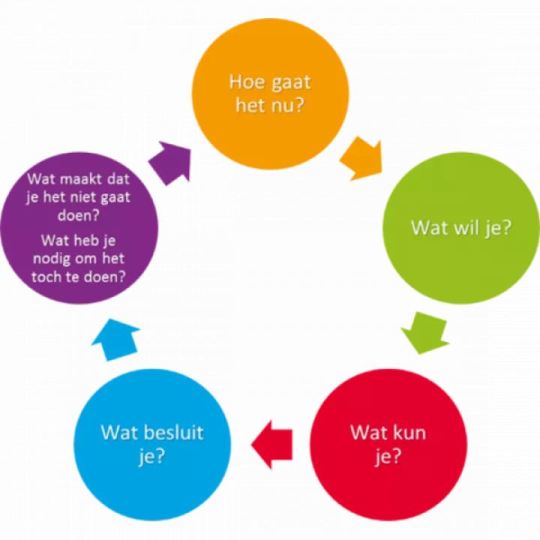
図1(Figure1): Institute for Positive Health (iPH) iph.nl. Applying action
(2) Action Wheels Method
This approach method ((Figure 2: Dutch) follows five steps to ask about the patient's health problems.
Step 1. How do you think about yourself now? What do you notice about your spider web?
STEP 2. What do you want? What is important to you?
STEP 3. What can you do? What is feasible for you?
STEP 4. What have you decided to do? What is your first step?
Step 5. What is the reason you have decided not to do it?
- 5A: What is the reason you have decided not to do it?
- 5B: What do you need to do it anyway?
こちらについても、具体例を見てみましょう。 患者は8歳の女の子で1型糖尿病を持っています。
母親と一緒に腹痛を主訴に家庭医を受診しました。
母は特に娘の腹痛を心配していました。医師はまず、事前に小児科の専門医の診察も受けたのか話を聞くと、母は「小児科の先生にも調べてもらったものの、特にこれ以上加療するような病態は見つからなかった、痛みは我慢するしかないと言われた」と答えました。
実際に医師が行った診察でも腹痛の原因について新しい手がかりは見つからず、機能性の腹痛(特に重大な病気が背景にあるわけではない、原因不明の腹痛の総称)が疑われていましたが、母親はもっと詳しい検査を医師に希望しました。
そこで医師は、女の子に向けて小児用の簡易版ポジティヴヘルスの質問紙を渡し、それを埋めてもらい次回予約で話し合うことにしました。

その後の外来で、医師は女の子に「あなたにとって何をしているときが一番大切ですか?」と質問すると「学校の友達が一番大切」と答えました。
この時の彼女のクモの巣図は「社会参加」と「身体機能」が特に点数が低い状態でした。
医師は続けて「もっと楽しい気分になるにはどんなことができたらいいですか?」と質問。すると患者は「友達の家に行って遊んだり、家に泊まったりしたい」と答えました。
この時母は娘について、糖尿病があることから学校以外の外出を一切許していませんでした。
というのも、母は娘のインスリン注射の管理について常に目の届く範囲に留めておきたいと思っていたためです。
そこで医師は「もっと友達と交流できるようになるにはどんなことがまず必要だと思いますか?また、初めにできることとしてはどんなことがありますか?」と尋ねました。すると女の子は、友達の母親も彼女の糖尿病について管理するのを許すのはどうかと母親に聞きました。母親は「ちょうど新しいパッチ型の糖尿病センサーの装置を受け取ったので、毎回注射を確認しなくてもいいかもしれない。正直、不安はまだ残るけどその装置があれば確かに娘の友達の家に行っても大丈夫かもしれない」と答えました。
まだ納得したような雰囲気ではない母親の様子を感じた医師は、さらに「このプランについてお母さんにとって妨げになっていることはありますか?」と重ねて尋ねました。
すると、母親はしばらく黙った後、涙を流しながら「実はいまだに娘の糖尿病について受け入れることが難しくてそれが辛い」と胸の内を告白しました。
医師は母親に対してこの気持ちと向き合うのを助けるべく、糖尿病専門の看護師に加えて、メンタルヘルス専門看護師との予約も勧めることにしました。
その後、母親は話し合ったプランを元に娘の友達の家でのお泊まりを認め、母親自身もカウンセリングを重ねながら少しずつ娘の状態について向き合う時間を作りました。
そして、その後女の子は腹痛を主訴に病院を受診することは無くなりました。
この例ではクモの巣図とアクションウィール法の面接を組み合わせることで腹痛だけではなく、友達との遊びができない女の子の苦悩を見つけることができ、さらに女の子の母親が抱えている不安や娘の病気の事実を受け入れられない本当の感情にも向き合うことができました。
また、クモの巣図での「社会参加」と「身体機能」の低値は女の子の本当の悩みを紐解く上での手がかりであり、健康問題の可視化を助けました。
以上、アプローチ別に2つの事例を紹介しました。
このようにクモの巣図をベースにメソッドに準じた振り返りにより実際に患者さんの健康にまつわる問題にアプローチすることができるのです。
Let's look at a specific example here as well.
The patient is an 8-year-old girl with type 1 diabetes.
She and her mother visited the family doctor with abdominal pain as the main complaint.
The mother was particularly concerned about her daughter's abdominal pain. The doctor first asked the mother if she had been examined by a pediatrician. The mother replied that she had been examined by the pediatrician, but he had found no particular condition that warranted further treatment, and that she would have to tolerate the pain.
The doctor's examination did not reveal any new clues as to the cause of the abdominal pain, and he suspected functional abdominal pain (a general term for abdominal pain of unknown cause that does not have any serious underlying disease), but the mother wanted the doctor to perform a more detailed examination.
The doctor gave the girl a simple pediatric version of the Positive Health Questionnaire, which she was asked to fill out and discuss at her next appointment.
In a subsequent outpatient visit, the doctor asked the girl, "What is most important to you in your life?". She replied, "My friends at school are the most important”.

Her spider web chart at this time showed particularly low scores for "participation" and " bodily functions”.
The doctor continued, "What would make you feel happier?" The doctor continued, "What could you do to feel more comfortable?”. The patient replied, "I would like to go to my friend's house to play and stay at home”.
At this time, the mother did not allow her daughter to go out outside of school at all because of her diabetes.
She wanted to keep her daughter's insulin injections under control at all times.
So the doctor asked, "What do you think is the first thing she needs to do to be able to interact more with her friends? And what are things we can do first?". The girl then asked her mother if she would allow her friend's mother to check her insulin. The mother replied, "I just received a new patch-type diabetes sensor device, so I may not have to check it by myself every time. To be honest, I still have some concerns, but with that device, she may indeed be able to go to her friend's house".
Since the mother still did not seem convinced, the doctor asked again, "Are there any obstacles for you with this plan?" . The mother was silent for a moment and then, with tears streaming down her face, confessed that she still had difficulty accepting her daughter's diabetes and that it was painful for her.
The doctor recommended that the mother make an appointment with a mental health nurse in addition to the diabetes nurse to help her deal with these feelings.
The mother then allowed her daughter to stay over at a friend's house based on the plan we discussed, and the mother herself gradually made time to confront her daughter's condition through a series of counseling sessions.
After that, the girl no longer visited the hospital with abdominal pain as her main complaint.
In this case, the combination of the spider web diagram and the Action Wheels interview enabled us to find not only the abdominal pain, but also the girl's distress at not being able to play with her friends, as well as the girl's mother's anxiety and true feelings of not being able to accept the fact that her daughter was ill.
In addition, the low values of "participation" and "bodily functions" in the spider web diagram were clues in unraveling the girls' real distress and helped visualize their health problems.
In this way, we can actually approach patients' health-related problems by reflecting on them according to the method based on the spider web diagram.
【今後のポジティヴヘルスの展望】
今回は主に診療所の場面においてポジティヴヘルスの使用についてご紹介しました。
オランダでは将来の診療の場において、ポジティヴヘルスを用いたアプローチはとりわけ健康に関して多様で複雑な背景のある患者(ホットスポッター)に対して効果的であるという期待があります。ホットスポッターとは具体的には以下のような因子を持つ方を指します。
1. 慢性・反復性の精神疾患がある、精神科への入院を繰り返す
2. 年間複数回の入院歴がある
3. 30日以内の再入院回数が多い
4. 一つ以上の慢性疾患がある
5. 3人以上の専門医による治療を受けている
6. 腫瘍病変があり、多くの検査、高次医療機関で治療を受けている
7. 緩和ケアを受けている
8. ポリファーマシー(多くの薬剤を内服している状態)がある
9. 薬物乱用歴がある
10. ホームレスである
11. ぜい弱性がある (フレイルがある)
12. 孤独である
13. 高齢である
In this blog I introduced some practical ways of Positive Health mainly in the clinic setting.
In future practice settings in the Netherlands, it is said that the Positive Health approach will be particularly effective for patients with diverse and complex health backgrounds (called ‘hot spotters’). Specifically, hot spotters are those with the following factors.
1. chronic or recurrent psychiatric illness, repeated psychiatric hospitalizations
2. a history of multiple hospitalizations per year
3. frequent readmissions within 30 days
4. one or more chronic illnesses
5. treated by more than 3 specialists
6. has a tumor lesion and is undergoing many tests and treatment at a higher level of care
7. receiving palliative care
8. has polypharmacy (taking many drugs)
9. has a history of substance abuse
10. homeless
11. has frailty (frail)
12. lonely
13. old age
ある家庭医のクリニックでの40名のホットスポッターを対象とした研究では、ポジティヴヘルスのアプローチを用いた面接により、患者の健康問題の改善やクモの巣図の点数の上昇、そして医療費の削減にもなるという結果が出ました。
また、更に診療現場以外の場面��例としては、カナダ在住のコロンビア人医師でかつ研究者のAlex Jadad氏が、ポジティヴヘルスのコンセプトをベースに様々なITテクノロジーを用いて地域住民、政府、医療、保険会社などがつながるネットワークサービスを作成しています。
具体的にはユーザーそれぞれに個別化されたウェルビーイングの評価や、最適な健康状態の実現を助けるインキュベーター(サポート役)として機能する健康アプリの開発を行い、そこに政府の医療サービス、医療機関、保険会社などの各種ステークホルダーが連携することでテイラーメイドなサービスを提供できる体制にしています。これにより実に9万5千ヶ所組織に所属する400万人以上の人々に健康にまつわる意思決定支援やネットワーク構築を行い、サービスユーザーの医療費をOECD諸国全体の平均支出額のわずか25%までコストダウンしたとされています。
このように今後ポジティヴヘルスは組織のネットワーク作りやプロジェクトの運営などにも利用されていくことが期待されます。
There was a study with 40 hot spotters at a family physician's clinic in the Netherlands, and it indicated that interviews using the Positive Health approach improved patients' health problems, increased spider web chart scores, and reduced health care costs.
As a further example of an off-site application, Alex Jadad, a Colombian physician and researcher in Canada, has created a network service that connects local residents, government, healthcare, and insurance companies using various IT technologies based on the concept of Positive Health.
Specifically, he has developed a health care app that will act as an incubator to help each user achieve an individualized wellbeing assessment and optimal health status, and by linking various stakeholders such as governmental medical services, medical institutions, and insurance companies to the app. Thus, the app can provide tailor-made services, health-related decision support and networking to more than 4 million people in 95,000 organizations. Moreover, it is said to have reduced the cost of health care for service users to only 25% of the average spending in the OECD countries as a whole.
Therefore, it is expected that Positive Health will be used for organizational networking and project management in the future.
更に2021年11月11日にはポジティブヘルス生誕10周年記念式典もあり、開発者のMachteld Huber医師をはじめとした基調講演、そして医療、教育、都市開発、健康管理サービスなど各分野の第一線で活躍するスピーカーによりそれぞれの分野でのポジティヴヘルスの活用についての紹介やワークショップがありました。会場には日本に初めてポジティヴヘルスを紹介した翻訳家のシャボットあかね氏をはじめ、多くの方々が来場していました。

写真1 : 筆者 (左)とHuber医師 (中央)、シャボット氏 (右)
Picture 1: author (left), Dr. Huber (center), Ms. A Chabot (right)

写真2 : 筆者 (左)とJadad氏 (右)
Picture 2: author (left), Dr. Jadad (right)
The 10th anniversary of Positive Health was celebrated on November 11, 2021, with keynote speeches by Dr. Machteld Huber, the developer of Positive Health, and speakers from the front lines of medicine, education, urban development, and health care services, who introduced the use of Positive Health in their respective fields. The event also featured workshops and introductions to the use of Positive Health in various fields, including medicine, education, urban development, and health care services. Many people attended the event, including Ms. Jeanette Akane Chabot, a translator who first introduced Positive Health to Japan.
今後の様々な可能性を秘めているポジティヴヘルスは、少子高齢化をはじめとした健康を取り巻く環境がより複雑化した日本でも活躍する場面があるかと私は思います。
本ブログを契機に読者の皆さん、一人一人が健康について見つめ直して、もっと考えを深める助けになれば幸いです。そしてもし興味があれば、是非共にポジティヴヘルスについてもっと学び、実践していきましょう。
今回はポジティヴヘルスの応用編ということで、最後までお読み頂きありがとうございました。
Positive health has many possibilities for the future, and I believe that it will play an active role in Japan, where the environment regarding health has become more complex, including the declining birthrate and aging population.
I hope that this blog will help you to rethink and deepen their thinking about health. And if you are interested, let's learn more about positive health together and put it into practice.
Thank you for reading to the end!
引用文献(Reference)
Huber M et al. Handbook Positive Health in Primary Care -The Dutch Example-.2022 Houten. bohn stafleu van loghum
【オランダ語とオランダのスナップショット(Snapshot of the Netherlands)】
-本日のオランダ語レッスン(Today’s Dutch lesson)-
‘Gefeliciteerd’ (ヘフェリシテード)
これはオランダ語で「おめでとう」という言葉です。
誰かの誕生日や結婚、出産、合格、卒業などのお祝いの場でもよく使われます。
オランダの大学では学期毎に2月、もしくは9月に卒業式があります。
私事ですが、昨年ライデン大学の大学院を無事に卒業できることとなりました。そこで多くのオランダの友人からも‘Gefeliciteerd’という嬉しい言葉を頂きました。日本にいる皆さんの周りでも、誕生日や結婚、出産などはもちろん、これから冬から春にかけて、受験や就職、卒業、など多くのめでたい節目が来るかと思います。ぜひ、いつもの「おめでとう」に加えて、オランダ式の祝辞もいかがでしょうか?
This is the Dutch word for "congratulations.
It is often used to celebrate someone's birthday, marriage, birth, passing exams, graduation, and other happy occasions. In the Netherlands, graduation ceremonies are held every semester in February or September. On a personal note, I am pleased to announce that I graduated from the graduate school, university of Leiden successfully. I was very happy to hear the word 'Gefeliciteerd' from many of my friends. I am sure that many of you in Japan will be celebrating birthdays, marriages, births, and other happy milestones from winter to spring, such as entrance exams, employment, graduation, and so on. In addition to the usual "congratulations," how about giving a congratulatory message in Dutch?
Photo(1): ライデン大学アカデミック校舎(大学最古の建物。400年以上の歴史がある)
ライデン大学の全学部の学士、修士、PhDなどの卒業式が行われる会場でもある
Leiden University Academic Building (oldest building at the university, with a history of more than 400 years). It is also the venue for Leiden University's graduation ceremonies for Bachelor, Master, and PhD.

Photo (2): 校舎に併設されたチャペル。ここで卒業証書授与を行います。
Photo (2): The chapel attached to the school building. Diplomas are conferred here.

Photo (3): 大学院卒業証書授与式にて筆者と学友との写真(この日に合わせて袴を着ました)
Photo (3): Photo of author with his classmates at the graduation ceremony (I wore ‘Hakama’ Japanese traditional cloths for ceremony).

Photo (3): ライトアップされた夜のライデンの街。クリスマスから冬の間は続く
Photo (3): The city of Leiden at night with light up. It lasts from Christmas holidays to whole winter times.

Photo (4): 冬晴れの太陽が照らすKatwijkのビーチ。北海に面し、海の向こうにはイギリスがある。
Photo (4): The beach in Katwijk lit by the winter sun. The beach faces the North Sea, with UK on the other side.

それでは、また次回のブログでお会いしましょう!
Tot zien in de volgende blog (See you in the next blog) !
2 notes
·
View notes
Text
There will be a lot of posts soon from people sharing how much they achieved in 2024. But in case someone needs to hear this, it's okay if the only thing you did this year was just get through it.... It's ok.
#spilled thoughts#spilled words#positive vibes#good vibes#mental health#inspiring quotes#words#text#love#feelings#quotes#quoteoftheday#2024#chipsy#motivating quotes
29K notes
·
View notes
Text
You don't have to force yourself to bounce back so quickly. I read something recently that said "when you come in from a rainstorm, you don't expect yourself to be dry and warm right away", and it really resonated with me. It's okay to take time to dry off and warm up. Take the time you need to process what happened to you.
#healing#mental health#recovery#positivity#self acceptance#be kind to yourself#self compassion#self love#hopecore#self care
25K notes
·
View notes
Text
it’s so important for your health to regularly interact with people at least a decade older than you who aren’t family, especially as a young person.
When my 45 year old teammate gives me advice on mental health and I know she understands because she’s had a tough adult life.
When my 32 year old friend tells me his life started improving for the first time the year she turned 30.
When the 60 year old man at the soup kitchen gives me permission to grieve by telling me I’m ‘just a baby’ with only gentleness in his voice.
It’s so much easier to abandon and break out from the cultural idealisation of youth when you surround yourself with wonderful people in all stages of their lives.
29K notes
·
View notes
Text
i just heard the phrase “if you wouldn’t trust their advice, don’t trust their criticism” for the first time and i don’t think i’ve ever needed to hear anything more
#lexi talks#people pleasing#people pleaser#social anxiety#self growth#self improvement#positivity#healing#mental health#personal growth#pathological people pleaser#in laws#mother in law#positive mental attitude#mental growth#positive quotes#positive mental health#mental health positivity
56K notes
·
View notes
Text

#funny#lol#haha#humor#meme#memes#mental health#dank memes#jokes#horror#goth#gothic#self care#positivity
16K notes
·
View notes
Text
Harnessing AI to Write My Book
My experience of how AI helps organize extensive content into a cohesive book. Ongoing, exciting, and frustrating process.
The Dream of Writing a Book For 30 years, the thought of writing a book has lingered. It was a dream that seemed just out of reach as I became overwhelmed by the sheer volume of material I had collected over the years. As a professor with over 20 years of experience, I have spent my career writing countless blog posts and approximately 70 professional articles. Moreover, I have produced numerous…
#SelfishSelflessSynergy#environment#paneugenesis#positive health#salutogenesis#selfish selfless synergy
0 notes
Text
i don't know who needs to hear this, but guilt, self-hatred and shame are not sustainable sources of growth and healing. you can't hate yourself into feeling better, or being better. you can't repeatedly punish yourself for your flawed humanity and expect wholesome results.
#mental health#recovery#self care#self love#positivity#reminders#healing#be kind to yourself#actually mentally ill#cptsd#actually cptsd#recovery suggestion#trauma survivor#trauma recovery#mine.
65K notes
·
View notes
Text
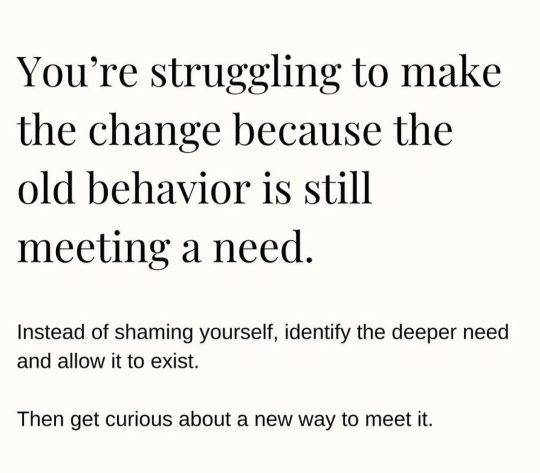
#change#mental growth#self growth#growth#mindset#self reflection#self improvement#self help#letting go#new life#positivity#new beginnings#inspirational quotes#mental health#be yourself
40K notes
·
View notes
Text

#wisdom#typography#graphic design#old photograph#old illustration#vintage photo#vintage illustration#strawberry#strawberries#quote#quotes#collage art#digital art#botany#plants#vintage#positive#life#my art#spilled ink#spilled words#spilled thoughts#art#artists on tumblr#mental health#multimedia art#reminder#berry#inspiration
22K notes
·
View notes
Text
You deserve a healthy love with someone who hears you, sees you, understands you, appreciates you, supports you, and loves you. Someone who is patient, communicates clearly, and creates a calm safe space to heal, grow, and bloom together. A love you don't have to heal from.
#love#life#relationship#friendship#feelings#mental health#love quotes#life quotes#daily quotes#thoughts#lines#literature#writing inspiration#writers on tumblr#qoutes#quotes#post on tumblr#quote#beautiful words#heartfelt#deep thoughts#positive thoughts#inspiring words#positive mental attitude#love quote#inspiring quotes#wisdom
15K notes
·
View notes
Text
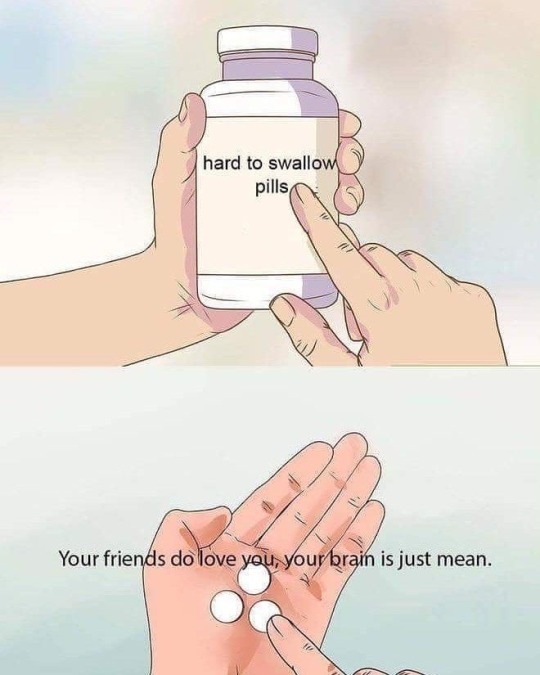
#mentally fucked#mental health#mental illness#actually mentally ill#positive mental attitude#wholesome#self love#meme#funny#funny memes#haha#humor#lol#memes#funny shit#weird memes#funny post
9K notes
·
View notes
Text
I love you everyone in red states right now.
I love you everyone who has family that is/will celebrate a Trump victory.
I love you everyone surrounded by loved ones actively voting against your rights.
If you voted for Kamala, you did everything you could and you should be proud.
All of your frustration and anger is justified, understandable, and fair.
I’m sending you all love and peace.
#mental health#positivity#self care#mental illness#self help#recovery#election#election 2024#presidential election#election day#us elections#us politics#kamala harris#kamala
9K notes
·
View notes
Text

15K notes
·
View notes